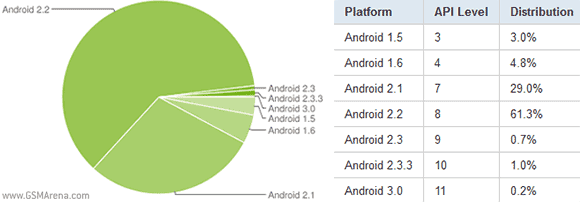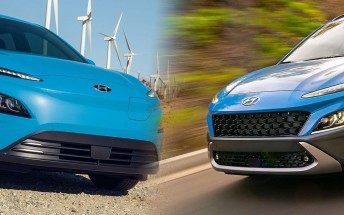Counterclockwise: Galaxy S phones, Omnia, Kindle Fire
Welcome to this week's edition of Counterclockwise – our weekly article that looks back in time at what happened over the same seven days in the last few years. This time around, we take a retrospective look at the future of smartphones, see how Android and Android app stores have developed over time and remember a natural disaster.

The way of the future
Touchscreens or at least tech similar to them has existed for decades, they are nothing new. Except no one took them seriously as the way of the future until in January 2007 Apple revealed the iPhone.
In March 2008, LG announced it will be offering the Touch Web phone in its home country. It wasn’t the company's first touch-operated phone though, that honor belongs to the LG KE850 Prada announced just before the original iPhone in January 2007.

A year later in March 2009 Samsung a leak revealed that Samsung is really stepping up its touchscreen game with thirteen new devices – an upgrade of the Windows Mobile-running Omnia phone and Samsung's first Android.




Speaking of screens, a fairly recent study published in March 2012 stated that the ideal screen size is 4-4.5". According to Strategy Analytics 90% of people wanted a big screen, especially Android users.

Back then the analyst firm pointed to web browsing, gaming and multimedia as the primary drivers for screen growth, but we guess it underestimated how much those things will overshadow the basic use for a phone – calling. Android has long since blown past the 4.5" size and 5"-5.2" will be this year's premier screen size. Unless you get a 5.5+ inch phablet, of course.
Non-telephony uses for smartphones were becoming more and more important and in March 2011 there was a dual-core shootout – to see which chipset can best handle the growing needs of growing screens and more complicated games and web sites.

Interestingly, the Snapdragon chipset lost to the Cortex-A9 chipsets. Of course, back then the Scorpion core was getting old and Qualcomm still hadn’t unveiled the Krait core, which a couple of years later will go on to dominate the market.
Playing cards
While phone makers are free to pick any screen or chipset supplier, they do have to agree on certain things – like the size and shape of SIM cards. That proved easier said than done.
After miniSIMs had ruled the phone world for years, microSIM caused a disruption, but in March 2012 Apple was already looking to a smaller format, nanoSIM. Nokia produced its own design, which gained Motorola and RIM's support.

Apple's design required a tray for the nanoSIM, which Nokia, Moto and RIM saw as unnecessary. Apple eventually got its way and both Nokia and Motorola have produced compatible nanoSIM devices. The other major makers are still sticking to microSIM, though.
In March 2010, a different kind of card was in the spotlight – the 32GB microSD card from SanDisk. We scoffed a bit at the price - $200 - but it was huge storage to put in such a small format.

Four years later at MWC 2014 SanDisk presented the first 128GB microSD card – it took the company four years to quadruple the storage. Price stayed the same though, the highest capacity card in 2014 is priced $200, just like the one in 2010.
App shopping
App stores are typically tied to their respective platform and the parent company keeps a tight rein on them – Microsoft is the main authority when it comes to Windows apps and Apple watches over the App Store like a hawk.
You can imagine the surprise of the Cupertino company when in March 2011 Amazon unveiled the Appstore (one word, no capital S). It was an Android-based app store and seemed like a surprising move – sure, Amazon had plenty of digital content, but that was music and movies, no software.




Later that year we found out this was just the opening move of a grander plan – fork Android, make an affordable tablet and use it to push the other digital content. We're talking about the Kindle Fire, of course.
The free app promotions (that run to this day) were just the bait from Amazon to get you into its services. The Kindle Fire has evolved and now rivals flagship tablets of other companies.
Not that Google was going to worry over it – the Android Market (later renamed Play Store) was busy catching up to its real competitor, the Apple App Store, but it wasn’t up to par yet.

The Amazon approach was recently mimicked by Nokia, which forked Android, put its own app store on it and is pushing it as a separate platform.
Anyway, the suit Apple filed against Amazon in 2011 failed as "app store" was recognized as a generic name.
A good year
In March 2010 Canalys predicted a good year for Android in North America. To quote our article from that day "RIM is still king of the hill with 43% estimated market share for 2010". Not three years later RIM was shopping itself around, looking for a buyer.

The US government is looking at Samsung and LG as replacement for government phones, which will be the death knell for RIM (now BlackBerry).
But we digress, it's Android we wanted to talk about. A year after the prediction from Canalys, 2.2 Froyo powered over 60% of Android-powered devices, with 2.1 Eclair holding about 30%.

This was a problem we touched on last time – slow updates. The same week as the Android distribution numbers came out, the Motorola Milestone was just getting the 2.2 Froyo update.
At the same time, LG was promising 2.3 Gingerbread for the Optimus One in May, while Samsung was postponing the Ice Cream Sandwich for the original Galaxy Note.
Note that Eclair was unveiled in January 2010, Froyo in May 2010, Gingerbread in February 2011 and Ice Cream Sandwich in December 2011. That's two major Android revisions from Google per year, while phone makers average one per year.
Things aren't always that slow though - in March 2010 Samsung released the 2.1 Eclair for the Galaxy Spica, while HTC confirmed the Hero will get Eclair in April that year.
It’s also worth pointing out that Windows Phone barely existed back then – Microsoft was just confirming the hardware requirements for the OS, while the legendary Toshiba TG01 was getting updated to Windows Mobile 6.5.
Galaxy S loves March
For some reason, Galaxy S phones love mid-March. Around this time last year, the Galaxy S4 went official and was seeing 40% higher demand than its predecessor. The predecessor, the Galaxy S III was unveiled in May, though official confirmations and leaks were already flying in March 2012.
A year before that, the Galaxy S II went through its first review with flying colors. At the same time, Samsung quietly launched the Galaxy SL in India.

The strong relation between the Galaxy S line and March continue even with the latest phone – pre-orders for the Galaxy S5 have already started.
A natural disaster
On March 11 2011, a massive 9.0 earthquake hit Japan, the biggest ever recorded in the region. It was followed by an equally massive tsunami.
A week later, Sony Ericsson reported that all its employees in the Tokyo offices are okay, but that the company might experience supply disruptions. Many electronics suppliers are Japan based, so the phone maker was evaluating secondary suppliers to recover.
HTC also issued a report saying its operations are unaffected and it has a framework of secondary suppliers already in place.
Related
Reader comments
- AnonD-330136
- 12 Nov 2014
- vaQ
Great Featured are this available now? Anyway, Does anyone here use Clippings.io for organizing book notes? Just wondered how anyone else was managing their notes?
- Anonymous
- 25 Mar 2014
- 4QS
Riiiiiiiiigggghhhhhhhtttttt......... On what planet? Where was the Capactive buttons? The removable back? The different designs including the Captivate with the design similar to what many Xperias used after...Which I like better in that size fra...
- Protocol
- 24 Mar 2014
- t}G
Truth hurts and you're probably hurt by truth. For copying the iPhone, Samsung is still paying. Lol.








 Samsung
Samsung Huawei
Huawei Samsung
Samsung Apple
Apple Xiaomi
Xiaomi


